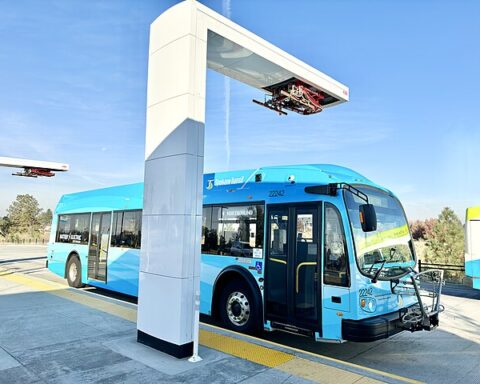In an effort to reduce carbon emissions and find more efficient ways to serve riders in hard-to-reach areas, Houston METRO will launch the second phase of an autonomous vehicle (AV) pilot program in January.
The agency is one of many nationwide working to transition its fleet to zero-emissions vehicles (ZEVs). By 2030, METRO aims to procure only ZEVs and reduce greenhouse gas emissions by 50% from 2005 levels. These goals were laid out in the agency’s Climate Action Plan the METRO board approved in 2022.
One goal of METRO’s AV program is to study how the vehicles can interact with passengers and pedestrians and also use public transportation to connect hard-to-reach areas of the city. The first phase of the pilot was launched in 2019 to provide last-mile trips near Texas Southern University (TSU), located in the Third Ward, a historically Black neighborhood.
In the second phase, METRO is expanding the pilot to have the vehicle operate with other vehicles. The fixed route will serve the Third Ward with stops at TSU and the University of Houston. The trips will be free to riders.
“The Third Ward community, we do have high-capacity bus and rail, but there is also a challenge with first- and last-mile connections,” METRO Innovation Project Manager Jamila Gomez told Government Market News. “So we’re just aligning two stops along the route with our existing bus stops. And as we’ve mentioned, that will connect riders to the Eastwood Transit Center … and our Park & Rides and other bus routes in the city of Houston.”
The 14-passenger zero-emission shuttle bus can operate without a driver, but a full-time operator will be on board for safety and to allow the operator to learn more about how AVs operate, said Kim Williams, METRO’s chief innovation officer.
“What we’re looking to learn out of this is whether or not we’ve got the right vehicle, and whether now that we have one that meets all the requirements and that is a larger size, just to kind of retest the assumptions we had in Phase 1 in terms of user acceptance, operational capacity and also exploring more along the lines of what and how an electric vehicle will do in transit operations,” Williams said.
Looking to the future
For Phase 2, METRO used a series of public-private partnerships (P3s) to procure the new vehicle that met federal requirements for accessibility but also had the latest technology. Phoenix Motorcars provided the base for the vehicle and converted the gas-powered shuttle to accommodate autonomous technology, Williams said. METRO worked with Perrone Robotics and engineering firm STV Inc. on the technology.
“We’re also hoping that [the AV program] will encourage other vendors to come into the market,” she said. “When we started, we didn’t have a vehicle that we could purchase off the shelf, if you will. And we’re hoping that when the vendor community sees the success of this project, that more will come into the market.”
The city of Houston’s Climate Action Plan notes that buses made up 1% of emissions from vehicles, but the agency is looking to keep reducing emissions through other sustainable efforts, Williams said. METRO also has hybrid and compressed natural gas (CNG) buses and will soon roll out 20 battery-electric buses through its contract with Novabus.
“The next step is to look at hydrogen, which is a different type of electric bus or fuel-cell electric bus,” she said. “We’ll be looking to bring those on or at least start that process in [2024, but] probably won’t see those vehicles until [2025] due to the timeline it takes to get those vehicles in.”
Other transit agencies throughout the U.S. also have AV programs using zero-emission vehicles. In November, the Contra Costa Transportation Authority (CCTA) and Tri Delta Transit in California announced a P3 project with the East County Connection Partners to offer on-demand transit for residents east of San Francisco. Using electric Glydcars, the AV operates on a dedicated guideway to reduce operational costs and holds up to four passengers.
Called the Dynamic Personal Micro Transit Project, the next steps include identifying a segment of the project that could receive grant funding, starting the environmental process and completing 30% of the design.
“It’s a bold step towards a more sustainable and accessible future for Contra Costa,” CCTA Board Chair Federal Glover said in a news release.
Funding AV efforts
To help with the cost of the AV program, METRO applied for a grant from the Federal Transit Administration’s Accelerating Innovative Mobility (AIM) Project and was one of 14 transportation authorities awarded funding in 2021. The AIM initiative helps awardees identify, test and innovate with new technologies for transportation.
METRO received $1.47 million for Phase 2 of its AV program. The funds helped cover over 62% of the cost of the autonomous vehicle pilot program with METRO covering the remaining $844,000.
The Western Reserve Transit Authority (WRTA) in Ohio was awarded $2.33 million in AIM funds, which it will use to partner with the Santa Clara Valley Transportation Authority in California to operate accessible automated electric vehicles in different climates and operating conditions. In 2022, First Transit announced it was partnering with WRTA and Perrone Robotics to operate the AVs, which would also have operators on board.
“We’re excited to play an active role in bringing AV and zero-emission vehicles to the Mahoning Valley, a.k.a, ‘Voltage Valley,’” WRTA Executive Director Dean Harris said in a news release.
The FTA is continuing its funding of AV programs and has $25 million to distribute through its Rural Autonomous Vehicle (RAV) Program. Nonprofit colleges and universities can apply for funding for projects that involve researching and partnering with rural and Tribal areas on how AVs could be used to address transit challenges. Applications are open through March 13.
All news and information on this site is provided by the team at Strategic Partnerships, Inc. Check out this short 1-minute video that provides a quick overview of how we work with clients.













